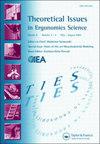Video image-based posture assessment: an approach for dynamic working posture assessment
IF 1.4
Q4 ERGONOMICS
引用次数: 0
Abstract
Abstract Traditional observational posture evaluation methods stress on sampling approach for continuous evaluation of dynamic postures in any activity. Hence, the quality of results from such evaluations is under debate. This article proposes a Video Image-based Posture Assessment (VIPA) method as a highly capable one for assessing an activity requiring dynamic postures of workers. This article explains the various steps of VIPA and its application for (i) the extraction and classification of postures into different categories based on the instructed posture classes from 10 videos of soil loosening activity having 48,715 postures and (ii) the use of OWAS to evaluate the postures. VIPA relies on traditional posture evaluation methods. The results indicate that VIPA could identify precarious postures 30% of the activity duration; these results were found to be accurate and reliable because there is no sampling method involved. The capability of VIPA method is proven through the activity studied.基于视频图像的姿势评估:一种动态工作姿势评估方法
摘要传统的观察性姿势评估方法侧重于抽样方法,对任何活动中的动态姿势进行连续评估。因此,这类评价结果的质量问题正在讨论之中。本文提出了一种基于视频图像的姿势评估(VIPA)方法,作为一种高效的方法来评估需要工人动态姿势的活动。本文解释了VIPA的各个步骤及其应用:(i)根据48715个姿势的10个松土活动视频中指示的姿势类别,将姿势提取并分类为不同类别;(ii)使用OWAS评估姿势。VIPA依赖于传统的姿势评估方法。结果表明,VIPA在活动持续时间的30%内可以识别不稳定的姿势;这些结果是准确可靠的,因为没有涉及抽样方法。通过所研究的活动证明了VIPA方法的能力。
本文章由计算机程序翻译,如有差异,请以英文原文为准。
求助全文
约1分钟内获得全文
求助全文

 求助内容:
求助内容: 应助结果提醒方式:
应助结果提醒方式:


